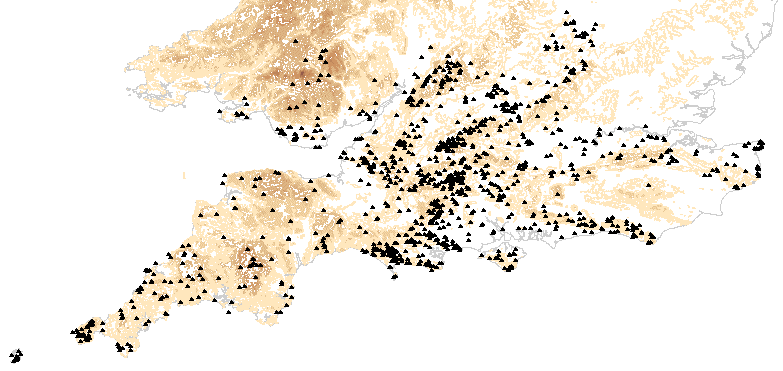
Distribution of sites in study area
Over 1700 prehistoric burial sites have been summarised and analysed for Southern Britain from the start of the Early Neolithic, through the Neolithic, Bronze and Iron Ages up to the Roman Invasion in AD43. This is the first time that such a study - covering c.4400 years of British prehistory - has been undertaken on such a scale or in such detail. The article includes the complete database of sites on which the research was based, with the facility to search using a wide variety of characteristics in combination so that the reader can construct their own collections with focuses of special interest. There is a bibliography of over 2700 references which can also be searched, and collections made relevant to sites or areas. Site and bibliographic references are accessible from the article's main text.

Distribution of sites in study area
The aim of this research was to identify the elements contributing to mortuary ritual, and then if possible to analyse the purposes and meanings underlying the mortuary activity. In doing this, the research also sought to compare changes in patterns of behaviour and belief over time, for and between the south-west, south and south-east areas of Southern Britain.
After initial analyses of mortuary process from the evidence of the sites themselves, anthropological theory about mortuary ritual was next examined and a generic model built to which the initial analyses were related by testing propositions on practice and belief. No prejudices were held about likely outcomes, and the analysis and synthesis was made as scientific as possible.
The results appear to show that beneath the superficial differences of expressed form, a remarkable continuity of underlying mortuary ritual existed throughout the four and a half millenia; and also the probability that essential beliefs about relationships between the dead, the community of ancestors, the living community, and the kin of the dead may have changed little through the period. Some ideas about societal change have support, for example the likely gradual transfer of influence from those drawing their power from ancestor associations to those with material power, as the influence of ancestors declined to be replaced by that of powers seen as deriving from forces of nature which directly affected living. Spiritual and temporal power wielders may have emerged to co-exist in the last centuries.
This research (based on my PhD thesis) was published in print as British Archaeological Report British Series 274 in 1998 (ISBN 0 86054 959 3). The print version has its own advantages. This electronic version improves considerably the reader's ability to focus on particular periods or regions in the article by using the hypertext links, and as a very major benefit offers search facilities on the Gazetteer and Bibliography quite impossible in print. Thus researchers may construct their own enquiries, make their own collections, and conduct their own analyses, and indeed recode the sites for their own purposes if they do not wish to visit the original literary sources. The electronic version has also benefitted from a number of corrections and improvements to the original (removing some of the more obvious signs of it having been a thesis), although the evidence has remained untouched.
The medium of electronic publication offers much scope for extending the power of the researcher to use the original data. For example, this version contains a number of distribution maps - no such maps appeared in the printed version. The gazetteer itself has also been offered as a download for researchers to redesign the content or refine the data for their own purposes, enabling the dedicated reader to make their own distribution maps from their own selections from the Gazetteer data.
Go to article Table of Contents
Peter Bristow
Open University
Milton Keynes
Email: P.H.W.Bristow@open.ac.uk